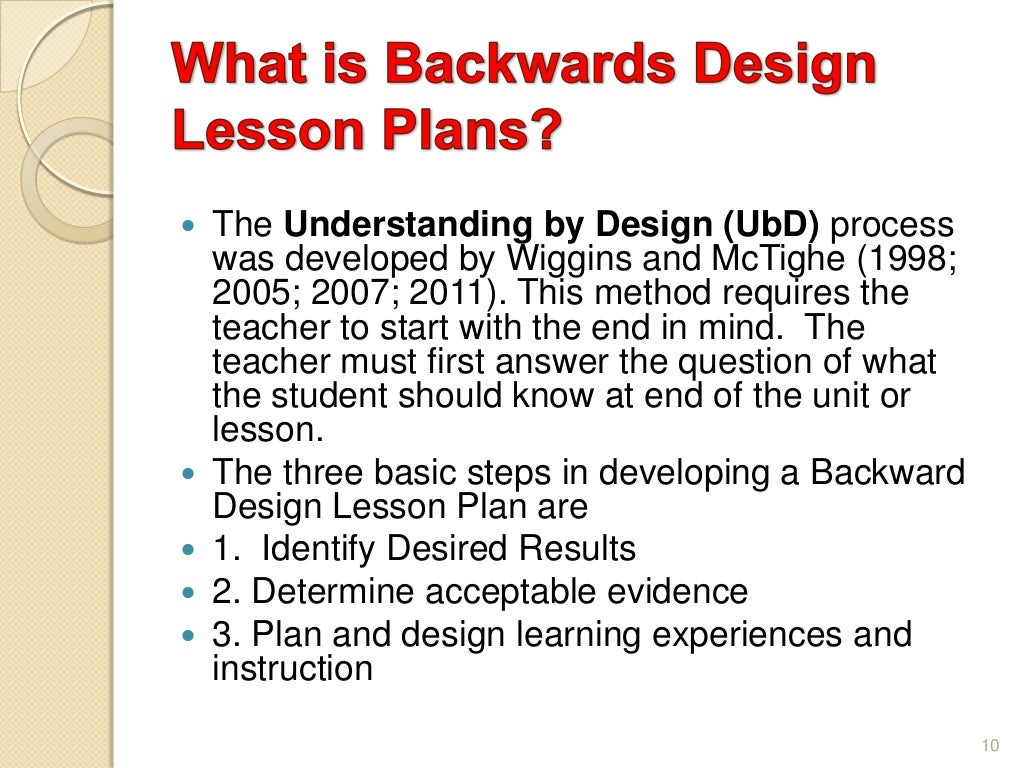Table Of Content

I mean, even though I loved the book, my students’ response to it was mostly lukewarm. Maybe it was the connections I was able to make to the stuff students dealt with on a day-to-day basis. I taught that book a few times, and even though I looked forward to it every time, I always finished the unit a little unsatisfied. The big ideas and important understandings are referred to as enduring understandings because these are the ideas that instructors want students to remember sometime after they’ve completed the course. One criticism of this approach is that is appears to promote “teaching to the test”. Yet despite the negative connotation that comes along with that phrase, arguable teaching to the test is exactly what the role of the instructor should be.
Stage 1: Identify desired results
So if we re-do this unit plan with backward design, we’ll need to start by developing an assessment that would measure success with that standard. That means the assessment would not be a test where students merely label the moon phases, but a student-developed model of the moon phases along with some kind of presentation where students use that model to explain lunar phases, eclipses, and seasons. If we assume that a large portion of a student’s grade is based on the test, then students are not being measured on their achievement of that standard.
Greenfield High School principal settles in, crafts vision for future - The Recorder
Greenfield High School principal settles in, crafts vision for future.
Posted: Sun, 06 Feb 2022 08:00:00 GMT [source]
Examples of Well-Crafted Learning Objectives
Again, there are numerous strategies for enhancing students’ learning experience, and again, the ones you choose should align well with the goals you’ve defined for the course. For instance, exercises that are active and collaborative allow students to explore new concepts and idea in a relaxed way that encourages them to “own” them. Exercises designed to allow students to practice using new knowledge, or gain new skills, will give them a sense of mastery over the content that mere memorization cannot. Posing hypothetical questions or problems designed to allow students to apply new knowledge, or to practice newly acquired skills, will give them a sense of mastery that mere memorization cannot. This phase is essentially a way of helping you structure evaluative strategies into the course design so that you are able to gauge students’ progress towards the desired learning outcomes.
Related content
The "Practice Standards" are basically endless formative assessments that lead students to mastery. Secondary teachers tend to think that every thing has to be graded, but non-graded is formative, too. Once you have worked through the three steps of backward design, you should make sure that all elements (objectives, assessments, learning activities, and instructional materials) align with each other.
What’s the meaning of this? - SmartBrief
What’s the meaning of this?.
Posted: Wed, 01 Mar 2017 08:00:00 GMT [source]
The emphasis was on “lectures” and “discussions” and the assumption was that learning largely consisted of a passive activity in which students received information and ideas from authoritative sources. Examples of summative assessments include exams, portfolios, presentations, written work. The inner circle identifies enduring understandings or big ideas that students should retain after they have forgotten many of the details (Wiggins and McTighe 1998, 9-10).
When I taught seventh grade language arts, one of my favorite things to teach was S.E. After we did some reflecting, writing, and talking, we were ready to start the book. A unit or sequence of lessons framed around enduring understandings and essential questions. Identifying the desired results for students by establishing the overall goal/s of the learning sequence/unit using syllabus standards.

Research over the past several decades has shown that students learn more and retain their learning longer if they acquire it in an active rather than a passive manner. In the past, classroom instruction has focused on the instructor and the ways in which the subject matter could best be presented to the student. The objective should include 1) the subject (your students), 2) an action verb, and 4) a noun that describes an intellectual operation or physical performance, as well as 3) a criterion and 5) the conditions for completion (Thomas and Abras, 2016).
UbD: Stages of Backward Design
For the first time, it felt like none of my class was wasted; everything actually mattered. There was something a lot more satisfying about doing things this way. And I got to drool over Matt Dillon in the movie’s opening scene again and again and again. By beginning with the end in mind, teachers are able to avoid the common problem of planning forward from unit to another, only to find that in the end some students are prepared for the final assessment and others are not. When you’re creating your learning activities, make sure they’re engaging and effective to help students learn and remember.
How to guides
Critics of backward design express concerns around a potential lack of flexibility in programming. Teachers may fear “teaching to the test” and not enabling authentic learning. Education authorities establish a curriculum in a top-down manner that may not fully address the circumstances in a classroom. Depending on the type of progress and performance you want to measure, you need to figure out what kind of assessment you want to use.
Teachers plan the required performance tasks and evidence of understanding. Performance tasks determine what students will demonstrate and what evidence will prove their understanding. In a sense, this is “teaching to the test.” But, in a subject with well-defined intended learning outcomes and assessments aligned with them, succeeding at these assessments is the evidence that students have met the subject’s goals.
This teaching guide will explain the benefits of incorporating backward design. Then it will elaborate on the three stages that backward design encompasses. Finally, an overview of a backward design template is provided with links to blank template pages for convenience. Notice that a general learning outcome (“tease out the laws of electromagnetism…”) is rather non-specific. You can also leverage technology to assess students’ understanding such as online quizzes, tests, exams, presentations, and project submissions. Let’s explore backward design in education, and how you can leverage it to make your teaching more effective.
Therefore, backward design is an effective way of providing guidance for instruction and designing lessons, units, and courses. Once the learning goals, or desired results, have been identified, instructors will have an easier time developing assessments and instruction around grounded learning outcomes. Because “beginning with the end” is often a counterintuitive process, backward design gives educators a structure they can follow when creating a curriculum and planning their instructional process. This process is often likened to a roadmap as the learning destination is chosen first, followed by the planning of the route, which in this case are the lesson plans. This focuses on promoting a better understanding of the content or processes to be learned for students. The educator is able to focus on addressing what the students need to learn and what types of data can be collected to show that the students have reached the desired learning outcomes.
In particular, beware of words like “understand” or “know.” Exactly what it means to “understand” or “know” something is open to interpretation. An undergraduate’s level of “understanding” of a topic and that of the instructor will vary wildly, and it will be difficult for students to know which level of understanding they should be aiming for. When developing ILOs, ask yourself how you will know that a student “understands” the material – what will they need to do, or say to demonstrate their understanding? Your answer to this question should provide you with more specific (and measurable ILOs.
Backward design, also called backward planning or backward mapping, is a process that educators use to design learning experiences and instructional techniques to achieve specific learning goals. Backward design begins with the objectives of a unit or course—what students are expected to learn and be able to do—and then proceeds “backward” to create lessons that achieve those desired goals. In most public schools, the educational goals of a course or unit will be a given state’s learning standards—i.e., concise, written descriptions of what students are expected to know and be able to do at a specific stage of their education. Backward design, also called backward planning or backward mapping, is a process that educators use to design learning experiences and instructional techniques to achieve specific learning goals.
The backward design model seeks to avoid those challenges by encouraging teachers to be much more intentional in their curriculum development and make the most out of class time. The idea in backward design is to teach toward the "end point" or learning goals, which typically ensures that content taught remains focused and organized. This, in turn, aims at promoting better understanding of the content or processes to be learned for students. The educator is able to focus on addressing what the students need to learn, what data can be collected to show that the students have learned the desired outcomes (or learning standards) and how to ensure the students will learn.

No comments:
Post a Comment